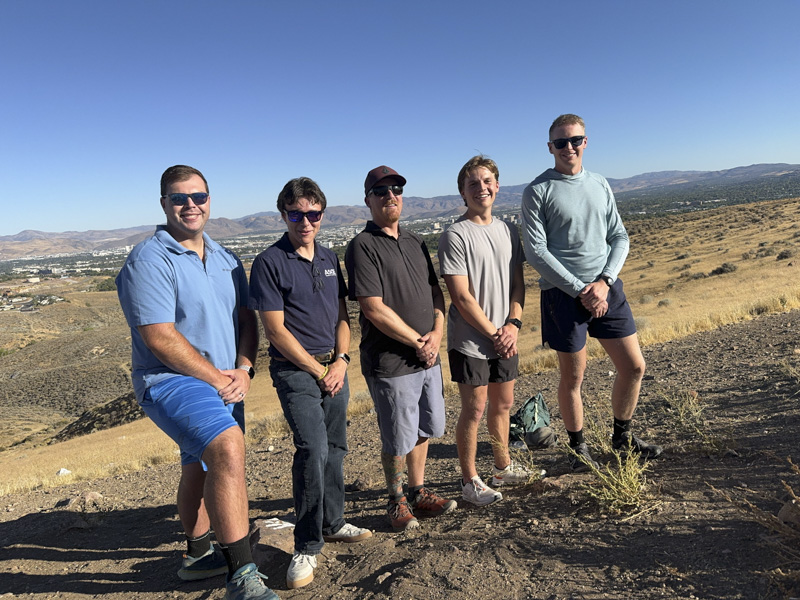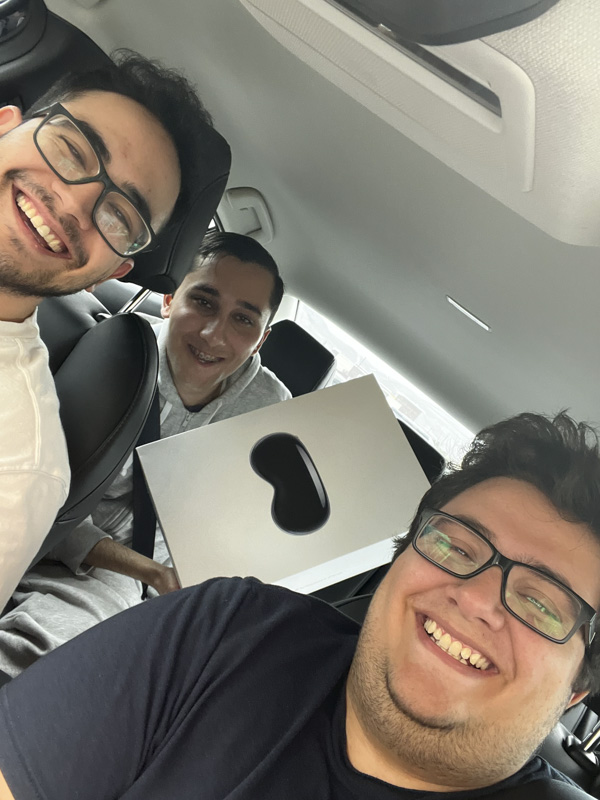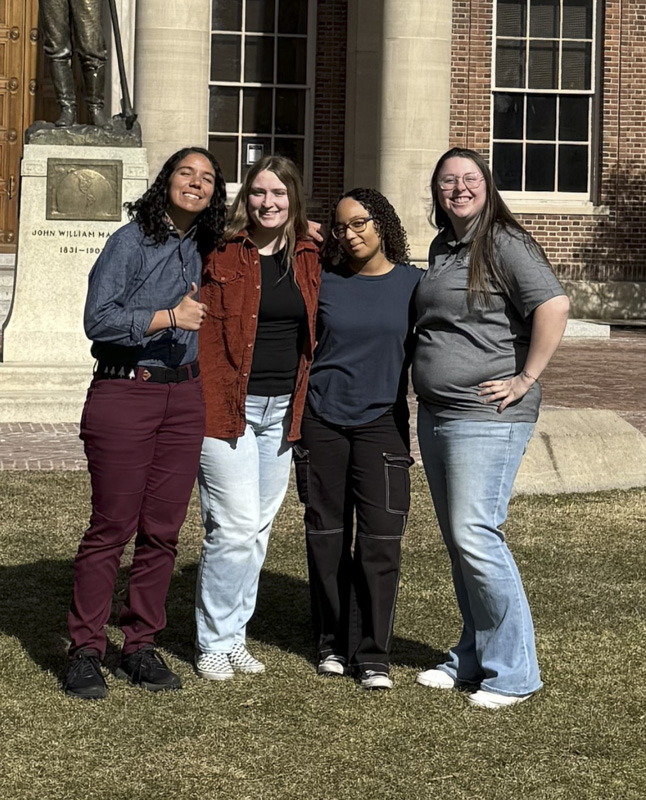Capstone Design Project Competition
Sponsored by Nevada National Security Sites
Objective
The primary goal of the Innovation Day Capstone Design Project Competition is to provide a platform for engineering teams in senior capstone design courses from various disciplines to showcase their knowledge, skills, and innovative solutions. The competition emphasizes the application of engineering design to produce solutions to societal problems that consider diverse factors, including health, safety, welfare, global, cultural, social, environmental and economic considerations. The two-part competition allows students to demonstrate their engineering design skills and ability to solve real-world problems that have a potential impact on a global scale.
Learn about our winning teams
-
CEE-18 University Village Pedestrian Connectivity Project

Team CEE 18 is Pat Phelps, Hilario Sanchez, Blake Hardin, Logan Miceli and Austin Long.Advised by Keith Dennett, PhD, PE, Camille Buehler, PE, PLS, Brian Moon, PE)
Students: Austin Long, Blake Hardin, Hilario Sanchez, Pat Phelps, Logan Miceli
The University Village Pedestrian Connectivity Project (UVPCP) is a multiphase infrastructure project aimed at enhancing pedestrian and micro-modal transportation between the University of Nevada, Reno (UNR) and Downtown Reno. As UNR expands southward, Interstate-80 (I-80) presents a physical barrier that limits safe and efficient access to the University Village, a proposed mixed-use, pedestrian development. This multi-phase project seeks to foster connectivity, safety, and economic growth. Phase One focuses on designing a pedestrian and cyclist only cable-stay bridge spanning I-80. This chosen design is beneficial due to its visual appeal, cost-effectiveness, constructability, and accessibility. Phase Two addresses site development for University-owned and surrounding parcels south of I-80, with considerations for grading, utility infrastructure, and traffic impacts that come with increased commercial development. Design efforts span multiple civil disciplines, including Structural, Environmental, and Transportation Engineering. The project integrates advanced design methodologies learned at UNR, industry-standard guidelines, and a new solution to create a safe, efficient, and vibrant campus extension. The UVPCP aligns with UNR's long-term vision and the City of Reno's master plan, reinforcing the university's role in regional development while improving mobility and urban connectivity.
-
ME-11 Wildland Respirator
Students: Christopher Pinar, Ashley Byrne, Troy Uemura, Tanner Schultz, Jordan Jackson
Over the past decade, roughly 595,000 wildfires burned 63.6 million acres across the US. Prolonged exposure to the smoke produced in these wildfires leads to an increased risk of cancer and cardiovascular diseases. With these risks, wildland firefighters have little to no options for protecting their lungs from the burnt material particulates. The little options that wildland firefighters do have either aren't efficient in filtering the air, too bulky, or make it too hard to breathe. This project aims to protect the lungs of wildland firefighters through a light-weight respirator that can filter out toxic particles and allows firefighters to work without constricting their movements.
-
CSE-13 MEDPASS - Predictive Assessment for Student Success
Advised by John Westhoff (UNR School of Medicine)
Students: Domminic Mayer, Rino David, Nolan Visitacion, Jake Herweg
The MedPass project aims to address the concerning decline in USMLE Step 1 examination performance among UNR medical students. This program serves to be a supplement to current learning resources and classes by utilizing predictive tools and machine learning models to analyze student performance data across multiple sources. By identifying specific knowledge gaps that could be overlooked due to the pass/fail grading system, MedPass creates personalized learning plans that are tailored to each student's unique needs. The platform analytics serve to benefit students but also faculty as well, who gain valuable insights into class/year-wide performance trends enabling targeted curriculum adjustments based on analysis. The MedPass program utilizes industry standard technologies and practices such as NextJS, Tailwind CSS, Pandas and more opening the door for continuous development and improvement. The project will serve as indispensable to a medical student's academic career as failing the USMLE Step 1 can dramatically alter a student's career trajectory and potentially reduce the already limited pool of new upcoming medical professionals.
-
CSE-20 SoulSync

Team CSE 20 is, left to right, is Joseph Jacobson, Vedant Malhotra and Shayan Hosseini.Advised by Sean Montgomery (Connected Future Labs)
Students: Vedant Malhotra, Joseph Jacobson, Shayan Hosseini
SoulSync brings user wellbeing and health data together into an app that brings users closer to friends and family, while giving them a greater understanding of their own mental health. By tapping into biometric information from devices such as the iPhone, Apple Watch, and EmotiBit, SoulSync can understand trends of a user's daily life. SoulSync also provides insights into all this data by encouraging the user to check in and take part in activities. Tapping into data from apps such as music, calendar, and health, and pairing it with data from hardware devices such as Apple Watch and EmotiBit brings a unique blend of analytics and insights to the user. The social aspect of SoulSync (SoulSync Social) allows users to share their emotions and more to others, fostering deeper connections with friends and family. SoulSync is also designed with privacy in mind, ensuring all health data is processed locally and on-device. Additionally, data inputs into SoulSync are all opt-in. SoulSync's unique blend of data processing and analysis means it's easier than ever to understand your health data while also providing a seamless and effortless way to check in with friends and family.
-
CEE-11 Ballpark-Museum Bridge project

Team CEE 11, left to right, is Jasmyne Crissey, Paige Bowers, Devynn Dunn-High and Kaylah House.Students: Devynn Dunn-High, Paige Bowers, Kaylah House, Jasmyne Crissey
In 2023, Greater Nevada Field drew over 300,000 fans, its highest attendance since 2015. To alleviate game-day congestion, we propose a two-way bridge over the Truckee River, linking Ballpark Lane and Museum Drive. This will improve traffic flow, enhance pedestrian access, and boost connectivity in downtown Reno.
Competition structure
In the culmination of the Capstone Design Project Competition, two distinguished awards will be presented to recognize outstanding achievements within the participating engineering teams. The judges will give four awards (two for engineering design and two for global impact) as they deem appropriate among all the entries. This year, there also will be a single "People's Choice" award.
The first accolade, Engineering Design, will be bestowed upon the team that demonstrates exemplary adherence to the established learning outcomes, emphasizing the meticulous application of engineering design principles to address specified needs while considering an array of critical factors such as health, safety, welfare, global, cultural, social, environmental and economic considerations. This award underscores the team’s commitment to academic excellence and the embodiment of core engineering competencies.
The second award, Global Impact, will celebrate the team that makes an extraordinary contribution to globally competitive innovation. This recognition will spotlight the project that exhibits unparalleled originality, practicality and potential impact on a global scale.
Thank you
This contest was made possible through the generous support of Nevada National Security Sites.
